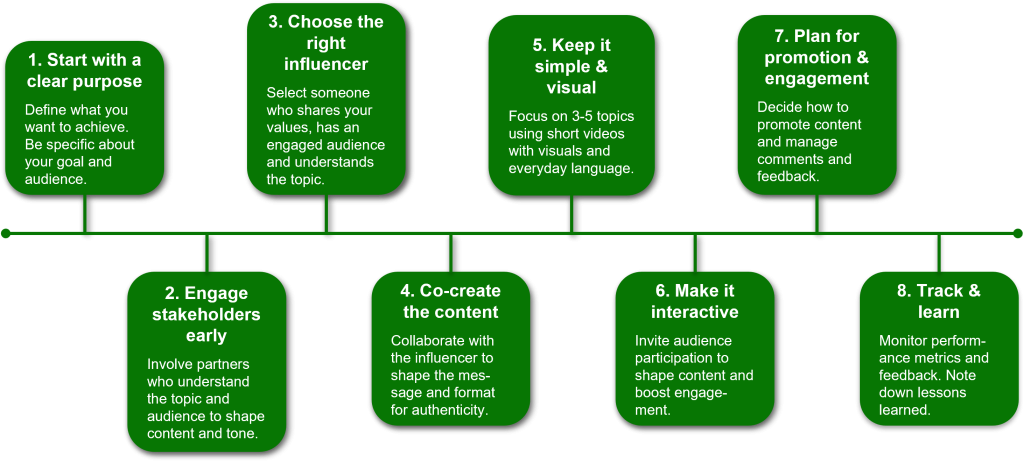How to Design an Awareness Campaign on Sustainable Packaging and Sorting
Author: Kaisa Simola, CLIC Innovation
We recently piloted a campaign that reached nearly half a million people through TikTok, Instagram, and Facebook. It was co-created with stakeholders, powered by a passionate influencer, and packed with practical tips for everyday life. In this article, we’ll share our insights on how you can do it too.
If you’re aiming to spark interest in sustainable packaging and sorting – especially among younger audiences – social media is a powerful and creative way to do it. This campaign format can be easily adapted to other sustainability topics or local priorities as well. Whether you’re focusing on food waste, energy use, or eco-friendly habits, the same approach applies.
Read more about social media awareness campaign on packaging and sorting we carried out in Finland:
The Most Important Requirements for Success
Influencer Match
Choose a credible influencer whose audience and values align with your campaign goals—this ensures authenticity and reach.
Stakeholder Co-Creation
Involve key partners from the start to shape content, provide expertise, and strengthen credibility.
Sufficient Resourcing
Allocate enough time and people – at least a core team of two – to manage planning, scripting, coordination, and feedback smoothly.
Step-by-step: How to Design an Awareness Campaign

1. Start with a clear purpose. Define what you want to achieve. Our goal was to raise awareness on the role of packaging and improve sorting habits, especially among young adults. Your goal might be similar – or it might focus on another audience or behavior. Be specific.
2. Engage stakeholders early. Bring in partners who know the topic and the audience. We worked with recycling organizations, environmental services, and other experts. Their insights helped shape the campaign’s content and tone.
3. Choose the right influencer. Find someone who:
- Shares your values
- Has an engaged audience
- Understands the topic—or is eager to learn
We partnered with a packaging designer who was already active on social media. Her credibility and creativity made a huge difference.
4. Co-create the content. Don’t just hand over a script. Work with the influencer to brainstorm topics, shape the message, and decide on the formats. This ensures the content feels authentic and resonates with the audience.
5. Keep it simple and visual. We created five videos, each focusing on one topic:
- Packaging legislation
- Purchase decisions
- Sorting and recycling
- Tips from followers
- A behind-the-scenes look at a recycling facility
Use engaging visuals, real-life examples, and everyday language. Avoid jargon.
6. Make it interactive. Invite your audience to participate. We asked followers to share their sorting tips and questions on hard-to-sort packaging. Their input shaped the content and boosted engagement.
7. Plan for promotion and engagement. Decide in advance:
- How you’ll promote the content
- Who will respond to comments
- How you’ll handle questions or criticism
8. Track and learn. Measure what matters: views, likes, comments, shares, and saves. But also pay attention to the tone of the feedback. Are people learning something new? Are they inspired to act?
9. Design, engage, inspire. Launching a social media campaign on sustainable packaging and sorting is entirely achievable with the right mindset, thoughtful planning, and strong collaboration. By engaging your audience, working as a team, and keeping the message clear and actionable, you can drive meaningful change.
Ready to get started?

Legislative Aspects
Ensure the campaign content aligns with current packaging and recycling legislation. While no legal permissions are required to launch such a campaign, referencing relevant laws—such as the EU’s Single-Use Plastics (SUP) directive—adds credibility and helps audiences understand the broader context of sustainable packaging.
Finance
Plan for a focused and strategic investment. Key cost areas typically include influencer collaboration, and campaign coordination. Public funding or public-private partnerships can support implementation. With thoughtful planning and the right creative partners, even a compact campaign can deliver strong results — as shown by the nearly 500,000 views achieved in the pilot.
Stakeholders
Involve key stakeholders from the beginning. Collaborate with organizations in packaging recycling, waste management, environmental services, and relevant NGOs or research projects. Their expertise helps shape accurate, relevant content and strengthens the campaign’s credibility and reach.
Society
Design the campaign to address real societal needs. Focus on groups with high potential for behavior change – such as young adults in our case – and use relatable, interactive formats to overcome cultural or lifestyle barriers. Social engagement is essential for impact, so ensure the tone is inclusive and empowering.
Environment
Shine a light on the positive impact of better sorting and smart purchase choices. Use the campaign to help people understand the full journey of packaging – from how it’s designed and used to how it’s sorted and recycled – and show how everyday actions can support a cleaner environment and a more circular future.
Organisation
Allocate sufficient time and resources for planning and execution. A preparation period of several months may be needed, especially when coordinating with stakeholders. If additional content production partners are required beyond the influencer, it is crucial to initiate contact as early as possible, taking holiday periods into account. A core team of two to four people is recommended to manage content development, stakeholder engagement, and feedback loops effectively.
Checklist
Here’s a checklist to guide your campaign planning and implementation.
[ ] Define your goal and audience
Define what you want to achieve. Be as specific as possible: Who are you trying to reach, and why? Understanding your audience’s values, habits, and communication preferences will help you tailor your message effectively and choose the right channels for impact.
[ ] Identify and involve key stakeholders
Engage partners who bring valuable expertise and understand your target audience. These stakeholders can offer insights, amplify your message, and help ensure the campaign is relevant and well-received.
[ ] Select a suitable influencer
Find someone who shares your values and understands the topic. Their credibility and connection to the audience can significantly enhance the campaign’s reach and impact.
[ ] Co-create content that’s clear, visual, and relatable
Collaborate closely with the influencer to shape the message and choose formats that suit both the topic and the audience. This joint effort helps ensure the content feels authentic, aligns with your campaign goals, and resonates with the audience’s values and everyday experiences. Using visual storytelling and relatable language helps ensure your message is both engaging and easy to understand.
[ ] Focus on 3–5 key topics and use short-form video for maximum reach
Keep your message simple and focused – trying to cover everything at once can dilute its impact. Choose three to five core themes that are relevant and actionable. Short-form videos are especially effective for reaching broad audiences, so consider using visuals, real-life examples, and everyday language to ensure your content captures attention and communicates effectively.
[ ] Include calls-to-action to engage your audience
Encourage your audience to take part – whether by commenting, sharing, responding to a poll, or tagging others. Clear calls-to-action invite interaction and make your campaign feel more participatory. Their input not only boosts engagement but also helps shape and refine your content to better match audience interests and needs.
[ ] Prepare for content promotion and comment moderation
Decide in advance how you will promote your content across relevant channels and how you’ll manage audience interaction. Establish a clear approach for responding to questions, feedback, or criticism. Being prepared helps maintain a constructive tone and ensures your message stays on track.
[ ] Track performance and gather feedback
Monitor key metrics such as views, likes, comments, shares, and saves to understand how your content is performing. But don’t stop at numbers – pay close attention to the tone and substance of the feedback. Are people learning something new? Are they engaging thoughtfully? Qualitative insights can reveal how well your message resonates and where there’s room to improve.
[ ] Document lessons learned for future campaigns
Every campaign is a learning experience – especially if it’s your first. Take time to document key aspects of your journey: what worked well, what could be improved, what surprised you, and any other insights that emerged. By capturing these reflections, you’ll be better equipped to navigate future campaigns and proactively address potential challenges.

